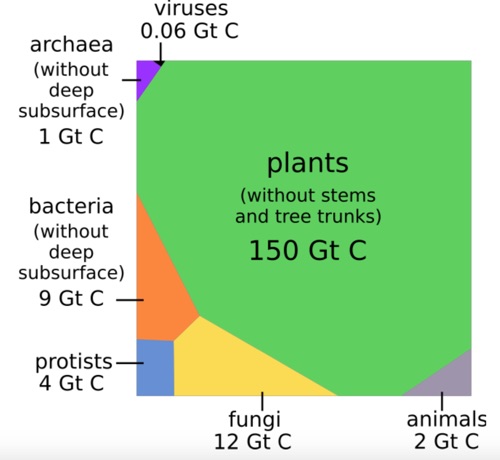News
7 October 2022
Plants and bacteria largely dominate world biomass
Nowadays, biodiversity is frequently present in the media and in everyday conversations. There is a concern for urgently protecting it as it is threatened by human activity that impacts it because of exploitation by humans of the environment and pollution created by synthetic chemical products [read]. As a result, the need for humanity to change paradigm, objectives and values is increasingly acknowledged [read].
Many studies have shown that biodiversity is decreasing that this trend is due in part to a decrease of the number of species (through the extinction of some of them), but also to a considerable fall of the number of individuals per species [read pp. 6-11]. This reduction is becoming a serious problem for food production (pollination and level of biological activity in soil, for instance) and it has important consequences on the carbon cycle [read].
In 2018, a study by three researchers [read] presents scientific estimates of the total amount of world biomass1 and its components. After considerable work, the authors estimate that the total biomass is about 550 Gt of carbon (1 Gt = 1 gigatonne = 1 billion tonnes), of which 470 Gt are terrestrial, 70 Gt are found in deep subsurface, and 6 Gt are marine. To have some idea of what this imposing figure means, it can be compared with, for instance, the approximately 50 Gt of CO2 eq. of greenhouse gases emitted very year by humanity.
In this enormous biomass, humanity itself only weighs around 0.06 Gt, or 0.01% of the total. This is an extremely small fraction, particularly if you think about the huge impact humanity has on its terrestrial [read] and marine [read] environment. In reality, the Earth’s biomass is overwhelmingly made of plants and bacteria that alone amount for 95% of the total. Table 1 shows the main components of world biomass, ranked by order of importance.
Table 1: Main components of world biomass,
by order of importance

Source: data from Bar-On et al. 2018.
-
* Archaea are microorganisms made of one unique cell that has neither a nucleus nor organelles, like bacteria, but they are different from them from the point of view of genetics, biochemistry and molecular biology.
-
** Protists are microorganisms that have a nucleus and have a simple cellular structure. They are mostly unicellular.
-
*** Animals other than humans and livestock.
If one ignores stems and trunks predominantly made of dead tissues, and metabolically “dormant” bacteria and archaea found in deep subsurface, the distribution of life can be represented in a diagram in which area denotes the weight of each group (Fig.1).
Fig.1 Graphical representation of living biomass

Source: Bar-On et al. 2018.
Another way of looking at biodiversity is to get an idea of the number of individuals and species that make up the different biomass groups (Fig.2).
Fig.2 Number of individuals and species in major biomass groups

Source: Bar-On et al. 2018.
Finally, among the analyses conducted by the authors of the study, it is particularly worthwhile to mention their estimate of the human impact on mammals (see Fig.3) which shows how humanity, by developing livestock, deeply modified the weight and composition of the biomass of mammals on the planet.
Fig.3 Human impact on biomass of mammals

Source: Bar-On et al. 2018.
From this diagram, one can see that over the period of 100,000 years, the biomass of wild mammals dropped by 80%, while total biomass of mammals increased more than four folds. Today, humanity and its livestock represent more than 9/10th of the biomass of mammals.
These data should make us ponder over our place on the Earth, simple specks of dust in the immense living world, as small as we are, we have an extraordinary impact on our environment.
It appears indispensable to monitor the evolution of the Earth’s biomass and its composition, so as to keep a precise (and indisputable) track of the changes that are affecting it because of human activities and their consequences in terms of climate disruption, natural resources degradation and pollution.
It is strongly hoped that the work done by these three authors will be updated periodically.
----------------------
Note:
-
1.Biomass: total amount of living organisms at a point in time in a particular place. It can be measured by its carbon mass, its volume or its number of individuals. For those energy experts, biomass represents the organic mass from which energy can be obtained by combustion or fermentation.
—————————————
To know more:
-
•Bar-On, Y.M., Phillips R., and R. Milo, The biomass distribution on Earth, PNAS, 2018.
Selection of past articles on hungerexplained.org related to the topic:
Last update: October 2022
For your comments and reactions: hungerexpl@gmail.com


